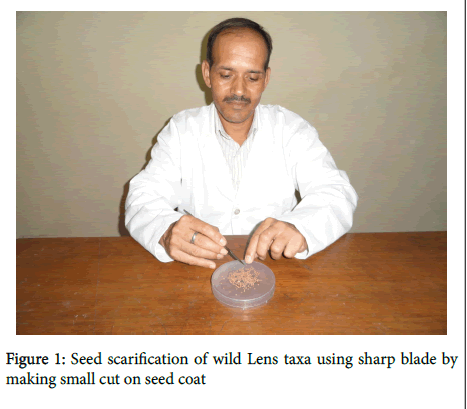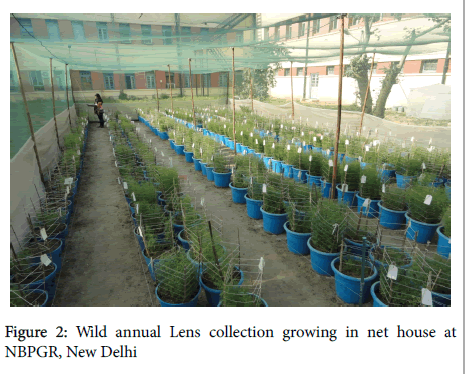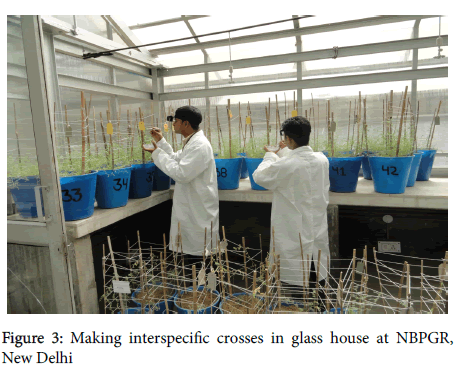A New Method of Phenotyping and Utilization of Wild Lens Taxa for Diversification of Primary Genepool
Received: 25-Jun-2014 / Accepted Date: 27-Jun-2014 / Published Date: 29-Jun-2014 DOI: 10.4172/2329-8863.1000e117
402884Introduction
The genus Lens is a member of the Vicieae tribe and comprised four self-pollinating diploid (2n=2x=14) species. Lens culinaris subsp. culinaris Medikus, encompassing two cultivated lentil on the basis of agro-morphological traits, the small seeded (microsperma) and large-seeded (macrosperma) and L. culinaris subsp. orientalis (Boiss.) Ponert, its presumed wild progenitor. The other sub-species and species are L. culinaris subsp. tomentosus (Ladz.), L. culinaris subsp. odomensis Ladz., L. ervoides (Brign.) Grande, L. nigricans (Bieb.) Godr. and L. lamottei Czefr. [1]. Lentil is an important pulse crop of Indian sub-continent, the Middle-East, Southern Europe and Eastern and Northern Africa. A critical appraisal of lentil cultivation and breeding in the past has relied primarily on local landraces of L. culinaris ssp. culinaris. Of late, modern lentil cultivars are derived from only a small number of improved landraces through pure line selection following hybridization between genotypes adapted to specific environmental conditions and seed size. These cultigens have some superiority over traditional varieties in terms of yield potential and disease resistance. Like other pulses, substantial improvement in the yield potential of lentil has not been achieved due to the lack of combination of genes for higher productivity, biotic and abiotic resistance, which are scattered in the cultivated and its wild relatives. Exploitation of wild gene pool for breeding purposes is a common practice in an increasing number of cultivated plants. In many cases, the wild relatives still possess important variation that no longer exists in their cultivated counterparts. Therefore, synthesis of new gene pool following hybridization and introgression from cultivated and wild types would make it possible to recreate some of the lost diversity in respect of productivity and other desirable characters. In this direction, a total of 463 global wild annual Lens taxa were introduced from the Biodiversity and Integrated Gene Management (BIGM) Unit at the International Centre for Agricultural Research in Dry Areas (ICARDA), Aleppo, Syria during 2010-11. These were further multiplied in adequate quantity, characterized and evaluated under different agro-ecological conditions for various qualitative and quantitative traits. We found that certain accessions of L. ervoides and L. nigricans does not flower properly during normal winter season and these accessions were planted again in summer himalayan nursery at Sangla in Himachal Pradesh during long days. The study revealed that remarkable variability with respect to genetic and non-genetic factors exists within the species and would be useful to the geneticists and breeders to plan phenotyping of wild Lens genepool.
Phenotyping Procedure
Seed multiplication and characterization
Arrange plastic pots of minimum 32”x32” size.
Fill up the pots with a mixture of top field soil and sand (3:1) and drench these pots with fungicide.
Mechanically scarify seeds of wild Lens taxa with a sharp blade by making a small cut on the seed coat (Figure 1) to improve water absorption and adequate germination. Without scarification of wild seeds, germination percentage will get reduced.
Before sowing of scarify seeds in the pots, dress the seeds with fungicides properly.
Grow 5 to 7 seeds in each pot of 32”x32” size in 2-3 inch depth.
Water the pots immediately after sowing and repeat this process at an interval of 5-6 days in winter and 2-3 days in summer season.
Place the pots for whole cropping season either in glass house or in net house preferably between 18-22°C. If the pots are kept in glass house and sometimes temperature increases beyond 30°C, under this conditions cover up the glass house with shade net.
Some species (L. nigricans and L. ervoides) require longer day length for flowering and to maintain long day conditions, artificial light can be provided to prolong day length particularly in the winter season and cloudy atmosphere.
After 15-20 days of sowing (DOS), germination percentage need to be recorded and if it is not more than 65 per cent, drench the pots with gibberellic acid (GA3) in 500 ppm to ensure more than 80 per cent germination.
At seedling stage (3-4 inches), hoeing is required twice in a month for rapid growth of wild taxa due to proper aeration in the soil.
One more drenching with fungicide is required, when seedling length reaches about 8-10 cm. It can be repeated, depending upon the growth and development of wild taxa.
By following above procedure one can get the optimum expression of wild taxa with respect to various qualitative and quantitative traits (Figure 2).
For phenotyping process, morphological observations need to be recorded using lentil descriptors (www.icarda.org).
Seedling stem pigmentation
Leaf pubescence
Leaflet size
Tendril length
Days to 50% flowering
Flower colour,
Plant height (cm)
Number of branches per plant
Number of peduncles per plant
Pedicle length (cm)
Pod dehiscence
Stipule shape
Number of pods per plant
Number of seeds per plant
Days to maturity
Seed shape at maturity
Seed yield per plant (g)
Biological yield per plant (g)
100-seed weight (g)
Ground colour of testa at maturity
Pattern of testa
Cotyledon colour
Harvest the seeds, when pods turn brownish in colour (it is noted that in majority of wild taxa, due to non-synchronous maturity behaviour, harvesting process takes 2-3 weeks’ time.
At the time of harvesting, collect the seeds separately from each individual plant to purify the seed lot.
Harvested dry seeds can be kept in a low humidity and at room temperature with maximum for four to five weeks’ time.
Process the genetic materials for long term storage in the gene bank.
Utilization of wild Lens taxa for diversification of primary genepool
Most of the lentil cultivars have an intrinsically narrow genetic base in India. This situation limits plant breeder’s progress today. The existing variability among indigenous germplasm has been exploited fully to reach to a maximum level of productivity. However, to attain further breakthrough in enhancing yield and improving stability in future cultivars, new source of variability need to be identified and incorporated into Indian germplasm. Wild species/taxa holds a wealth of useful alleles that, if we find them can help in breaking yield barriers and enhance tolerance to stresses for stability. The narrow genetic base of cultivars with low utilization of genetic resources is the major factor limiting lentil production and productivity worldwide. Wild relatives with enhanced level of resistance to various stresses provide important sources of genetic diversity for crop improvement. Furthermore, their use for varietal improvement/ genetic enhancement is limited by several cross-incompatibility barriers and linkage drags etc. In India, lentil breeding programme is normally undertaken during winter season. Certain accessions of wild Lens species which do not flower under these conditions would require artificially long days in the green house or growing in the summer himalayan nursery. It is therefore, imperative to know the effect of genetic and non-genetic factors on crossability in the genus Lens in order to help geneticist and breeders to plan wide hybridization programme while utilizing wild Lens taxa [2]. The study revealed analysis of performance of intersub-specific and interspecific crosses attempted under two growing conditions produced variable results with respect to pod and seed set percentage between cultivated x wild Lens taxa. The study concluded that maximum pod and seed setting percentage was observed between 13.9°C (minimum) to 23.4°C (maximum) temperature and overall performance of pod and seed setting was observed better under long days during summer season than normal winter season in which an average maximum/minimum temperature was 28.9°C – 18.5°C [2] (Figure 3).
Acknowledgements
The authors acknowledge the Genetic Resources Unit at the International Centre for Agricultural Research in Dry Areas (ICARDA), Aleppo, Syria, for providing world Lens collection. The authors also thank the Vice Chancellor, HPAU, Palampur, Himachal Pradesh, India for allowing use of the hot spot facility at Sangla and Dhaulakuan for phenotyping purpose and the Deputy Director General, Crop Science, ICAR for necessary support.
References
- Ferguson ME, Maxted N, Slangeren HV, Robertson LD(2000) A re-assessment of the taxonomy of Lens Mill. (Leguminosae, Papilionoideae, Vicieae). Botanical Journal of Linnean Society 133: 41-59.
- Singh, M, Rana MK, Bisht IS, Kumar K, Dutta M, et al. (2013) Broadening the genetic base of lentil cultivars through inter sub-specific and interspecific crosses of Lens taxa. Plant Breeding 132: 667-675.
Citation: Singh M, Gautam NK, Kumar K, Kumar S (2014) A New Method of Phenotyping and Utilization of Wild Lens Taxa for Diversification of Primary Genepool. Adv Crop Sci Tech 2:e117. DOI: 10.4172/2329-8863.1000e117
Copyright: © 2014 Singh M, et al. This is an open-access article distributed under the terms of the Creative Commons Attribution License, which permits unrestricted use, distribution, and reproduction in any medium, provided the original author and source are credited.
Select your language of interest to view the total content in your interested language
Share This Article
Recommended Journals
Open Access Journals
Article Tools
Article Usage
- Total views: 15633
- [From(publication date): 8-2014 - Sep 01, 2025]
- Breakdown by view type
- HTML page views: 10910
- PDF downloads: 4723



